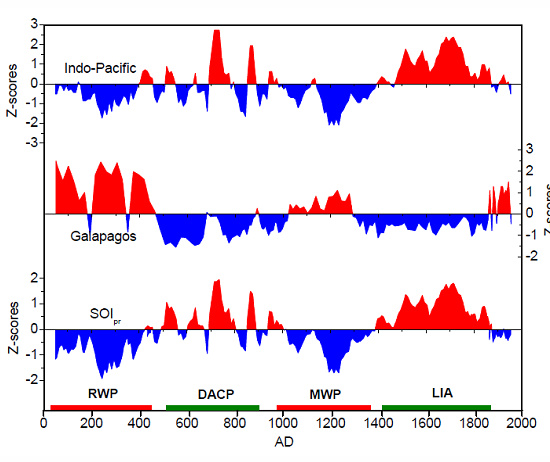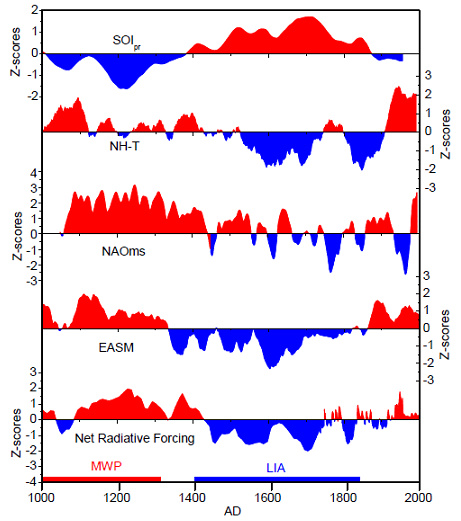SUN Liguang's Group at USTC Makes Important Progress in Research on Tropical Climate Change
A group of scientists led by Prof. SUN Liguang, from the Institute of Polar Environment, School of Earth and Space Sciences, University of Science and Technology of China (USTC) reconstructed variations of the Southern Oscillation Index (SOI) over the past two millennia and found that changes of SOI are significantly correlated to the solar irradiance and Northern Hemisphere climate. The paper entitled "A record of the Southern Oscillation Index for the past 2,000 years from precipitation proxies" by YAN Hong (Ph.D student of Prof. Sun) et al. was published in Nature Geoscience on August 14, 2011.

SOI proxy SOIpr (bottom)as the difference between the reconstructed precipitation records from Indonesia, in the western Pacific (top), and the Galapagos, in the eastern Pacific (middle). Cited from Nature Geoscience (August 14, 2011)
El Niño-Southern Oscillation (ENSO) is a coupled ocean-atmosphere phenomenon in tropical Pacific. Its variations can modify both the Hadley circulation and the Walker circulation and thus have profound impacts on global climates. In order to understand the long-term variation of El Niño, the global climate change, as well as their relationship,multi-proxy approaches have been utilized to extend the ENSO index record back in time by several studies. However, most of these reconstructed records only extended the ENSO index record by less than 1000 years; they did not include the Medieval Warm Period (MWP, AD ~800–1300), the most recent natural counterpart to modern climate warming.

Comparison of long-term proxy records SOIpr, Northern Hemisphere temperature (NH-T), North Atlatic Oscillation (NAO), East Asian Summer Monsoon (EASM) and solar irradiance over the past millennium. Cited from Nature Geoscience (August 14, 2011)
In this study, YAN Hong et al attempted to extend the multi-decadal scale Southern Oscillation Index (SOI) to 2,000 years ago using paleo-precipitation records. The reconstructed SOI proxy has five distinct phases over the past 2,000 years: persistent negative values during AD 50-450, AD 1000-1400, and AD 1850-1955 interrupted by positive values during AD 500-1000 and AD 1400-1850. For the past millennium, the SOIpr shows three phases associated with the solar irradiance and background climate state. Negative SOIpr values (indicating a more El Niño-like state) were associated with higher solar irradiance and global mean temperature during the Medieval Warm Period (MWP) and the so-called Modern Warm Period. On the other hand, positive SOIpr values (indicating a more La Niña-like state) were concurrent with lower solar irradiance and cooler global mean temperature during the Little Ice Age (LIA). The Sun’s group also examined the relationship between SOI and the Northern Hemisphere temperature and found a significant negative correlation over the past millennium. Hong Yan et al suggested that the dynamic link between the SOI and the Northern Hemisphere climate may be established by the interplay between El Niño-Southern Oscillation and Northern Atlantic Oscillation (NAO), monsoonal circulations and other mechanisms. These new findings are strong contributions to the research field of tropical climate change. Moreover, results from this study may have important implications in revealing the driving mechanism of climatic changes in tropical regions, and putting forward a new model for better predicting future climatic change trends.
This work was supported by the grants from the National Natural Science Foundation of China, and the Ministry of Science and Technology.
Yan H., Sun LG*., Wang YH., Huang W., Qiu SC., Yang CY., 2011. A record of the Southern Oscillation Index for the past 2,000 years from precipitation proxies. Nature Geoscience: doi:10.1038/ngeo 1231.
(Institute of Polar Environment, School of Earth and Space Sciences, USTC; News Center of USTC)
W020110818430320711431.jpg